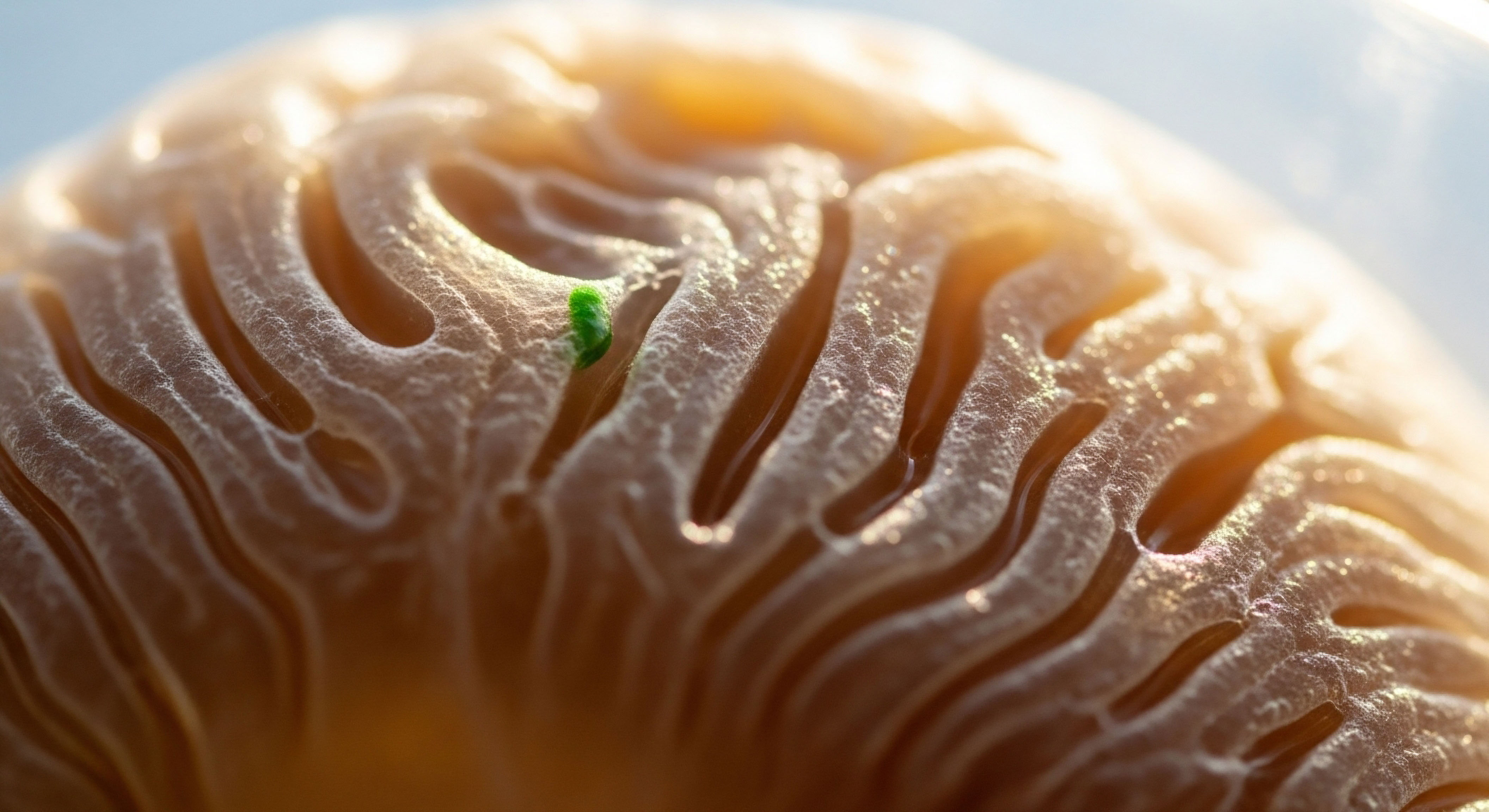

Fundamentals
The subtle shifts within your body, perhaps a persistent fatigue that defies rest, a quiet change in your mood, or a growing concern about bone strength, often whisper of deeper biological conversations. These experiences are not isolated occurrences; they represent signals from an intricate internal messaging system, a symphony of biochemical processes orchestrating your vitality.
Understanding these signals, and the underlying systems that generate them, marks the initial step toward reclaiming your full functional capacity. This exploration begins with a focus on hormonal health, particularly the often-overlooked role of testosterone in premenopausal women, and its profound connection to skeletal integrity.
Many individuals associate testosterone primarily with male physiology, yet it stands as a vital hormone for women, present in higher concentrations than estrogen before the menopausal transition. This biochemical agent contributes significantly to various aspects of female well-being, including sexual desire, muscle strength, cognitive clarity, and mood regulation.
Its influence extends critically to bone health, a domain where its importance is increasingly recognized. When levels of this essential hormone decline, whether due to age, medical interventions, or other physiological factors, the impact can extend beyond immediate symptoms, potentially affecting the very framework of your body ∞ your bones.
Understanding your body’s hormonal signals is the first step in recalibrating your internal systems for improved well-being.

The Dynamic Nature of Bone
Bone tissue is not a static structure; it represents a living, dynamic matrix constantly undergoing a process known as bone remodeling. This continuous cycle involves two primary cell types ∞ osteoblasts, which are responsible for building new bone tissue, and osteoclasts, which break down old bone.
A healthy skeletal system maintains a delicate equilibrium between these two processes, ensuring bone strength and density. Disruptions to this balance, where bone breakdown outpaces bone formation, lead to conditions such as osteopenia (reduced bone mass) and, if unchecked, osteoporosis (weakened, brittle bones prone to fracture).
For premenopausal women, maintaining robust bone density is paramount. Peak bone mass is typically achieved in the late twenties, and this serves as a critical reserve for later life. Factors influencing this peak bone mass, as well as subsequent bone loss, are multifaceted, involving genetic predispositions, nutritional status, physical activity, and, significantly, hormonal balance. A decline in key hormones can accelerate bone loss, even in younger women, underscoring the need for a comprehensive understanding of endocrine system support.

Hormonal Orchestration of Skeletal Health
The endocrine system, a complex network of glands and hormones, exerts profound control over bone metabolism. While estrogen is widely acknowledged for its protective role in female bone health, particularly in inhibiting bone resorption, testosterone also plays a direct and indirect part. Testosterone can directly stimulate osteoblasts, promoting the creation of new bone tissue.
Additionally, it can be converted into estrogen within bone cells through an enzyme called aromatase, thereby contributing to estrogen’s bone-preserving actions. This dual mechanism highlights testosterone’s importance in maintaining skeletal integrity.
Beyond sex steroids, other hormones contribute to the intricate regulation of bone. Thyroid hormones are essential for skeletal maturation and ongoing maintenance. Growth hormone and its mediator, insulin-like growth factor 1 (IGF-1), influence bone formation. Conversely, excessive levels of cortisol, a stress hormone, can impede bone growth and contribute to bone loss. This interconnectedness means that a holistic assessment of hormonal status provides a more complete picture of bone health than focusing on a single hormone in isolation.

The Hypothalamic-Pituitary-Gonadal Axis
Central to understanding hormonal balance is the Hypothalamic-Pituitary-Gonadal (HPG) axis. This sophisticated feedback loop involves the hypothalamus in the brain, the pituitary gland (also in the brain), and the gonads (ovaries in women). The hypothalamus releases gonadotropin-releasing hormone (GnRH), which signals the pituitary to produce luteinizing hormone (LH) and follicle-stimulating hormone (FSH). These gonadotropins then act on the ovaries, stimulating the production of estrogen, progesterone, and testosterone.
The HPG axis operates like a finely tuned thermostat. When hormone levels are optimal, the system maintains equilibrium. However, various factors can disrupt this axis, leading to hormonal imbalances that manifest as symptoms and, over time, affect systems like bone. Recognizing these interdependencies allows for a more precise and personalized approach to restoring physiological balance. The goal is to support the body’s innate intelligence in maintaining its systems, rather than simply addressing isolated symptoms.


Intermediate
For premenopausal women experiencing symptoms that suggest hormonal imbalance, particularly those with concerns about bone density, a careful consideration of targeted hormonal optimization protocols becomes a logical next step. While estrogen deficiency is a well-established cause of bone loss, especially as women approach and enter menopause, the role of testosterone in supporting skeletal health in younger women is gaining deserved attention.
This section explores the specific clinical approaches involving low-dose testosterone, detailing the methods and the rationale behind their application.
The objective of low-dose testosterone therapy in premenopausal women is to restore physiological levels of this hormone, thereby supporting its diverse functions, including its contribution to bone mineral density. It is important to distinguish this approach from higher-dose applications used in other contexts. The aim is to recalibrate the body’s internal environment, not to induce supraphysiological states. This precise recalibration seeks to alleviate symptoms while promoting long-term health outcomes, such as improved bone strength.
Low-dose testosterone therapy for premenopausal women aims to restore hormonal balance, supporting bone health and overall vitality.

Protocols for Hormonal Recalibration
Several methods exist for administering testosterone to women, each with its own characteristics regarding absorption, consistency of levels, and patient preference. The choice of delivery method is a collaborative decision between the individual and their healthcare provider, based on a thorough assessment of symptoms, laboratory values, and lifestyle considerations.

Subcutaneous Injections of Testosterone Cypionate
One common and effective method involves weekly subcutaneous injections of Testosterone Cypionate. This protocol typically utilizes a very small volume, often 10 ∞ 20 units (0.1 ∞ 0.2 ml), administered subcutaneously. This route allows for a steady, controlled release of the hormone into the bloodstream, avoiding the “first-pass effect” associated with oral administration, which can alter hormone metabolism in the liver. The precision of subcutaneous dosing enables fine-tuning to achieve and maintain physiological testosterone levels, minimizing the risk of unwanted side effects.
The rationale for this approach centers on providing a consistent supply of testosterone to the body’s tissues, including bone cells. Testosterone directly influences osteoblast activity, the cells responsible for building new bone. By supporting these bone-forming cells, low-dose testosterone contributes to the maintenance and potential improvement of bone mineral density. Regular monitoring of symptoms and laboratory values, including total testosterone and potentially free testosterone, helps ensure the dosage remains within the optimal physiological range for women.

The Role of Progesterone
For premenopausal women, the inclusion of progesterone in a hormonal optimization protocol is often essential, particularly if irregular cycles or other progesterone deficiency symptoms are present. Progesterone plays a critical role in the female reproductive cycle and also contributes to bone health by supporting bone formation.
Its presence helps maintain a balanced endocrine environment, working synergistically with other hormones to support overall well-being. The specific dosage and timing of progesterone administration are tailored to the individual’s menstrual status and clinical needs.

Considering Pellet Therapy
Another option for testosterone delivery is pellet therapy. This involves the subcutaneous insertion of small, long-acting testosterone pellets, typically in the hip or buttock area. These pellets provide a continuous, steady release of testosterone over several months, eliminating the need for frequent injections. For some individuals, the convenience and consistent hormone levels offered by pellet therapy are highly advantageous.
When utilizing pellet therapy, particularly in contexts where estrogen conversion might be a concern, an aromatase inhibitor such as Anastrozole may be considered. While less common in premenopausal women whose bodies naturally produce estrogen, Anastrozole can be used to prevent the conversion of testosterone into estrogen, especially if there is a clinical indication to limit estrogenic effects. This precise management ensures that the therapeutic benefits of testosterone are realized while maintaining overall hormonal equilibrium.

Monitoring and Adjusting Treatment
Effective hormonal optimization requires ongoing assessment and adjustment. Regular clinical evaluations, combined with laboratory testing, provide the necessary data to ensure the protocol is achieving its intended effects without inducing adverse outcomes.
| Parameter | Rationale for Monitoring | Typical Frequency |
|---|---|---|
| Total Testosterone | To ensure levels remain within the physiological range for women, avoiding supraphysiological concentrations. | Initially 3-6 weeks post-initiation, then every 6-12 months. |
| Free Testosterone | Provides insight into the biologically active portion of testosterone, less bound to proteins. | As indicated by clinical picture, often alongside total testosterone. |
| Estradiol (E2) | To assess estrogen levels, especially if aromatase inhibitors are used or if there are concerns about estrogen dominance. | Periodically, based on individual response and protocol. |
| Sex Hormone-Binding Globulin (SHBG) | Influences the amount of free, bioavailable hormones; high SHBG can reduce testosterone’s effectiveness. | Periodically, as part of comprehensive hormonal panel. |
| Bone Mineral Density (BMD) | Measured via DEXA scan to track improvements in bone strength over time. | Baseline, then typically every 1-2 years depending on clinical need. |
The goal of monitoring extends beyond numbers; it encompasses a deep understanding of the individual’s subjective experience. Are symptoms improving? Is vitality returning? These qualitative assessments, combined with quantitative lab data, guide the ongoing recalibration of the protocol. This personalized approach ensures that the therapy aligns with the individual’s unique biological landscape and wellness aspirations.

How Does Low-Dose Testosterone Support Bone Density in Premenopausal Women?
The mechanism by which low-dose testosterone contributes to bone density in premenopausal women involves both direct and indirect pathways. Directly, testosterone interacts with androgen receptors present on osteoblasts, stimulating their proliferation and differentiation. This direct action promotes the formation of new bone tissue, thereby increasing bone mass.
Indirectly, a portion of administered testosterone can be converted into estrogen (estradiol) within bone cells through the action of the aromatase enzyme. Estrogen is a potent inhibitor of osteoclast activity, the cells responsible for bone resorption. By reducing bone breakdown, estrogen helps preserve existing bone density.
Thus, testosterone provides a dual benefit ∞ directly building bone and indirectly protecting it through its conversion to estrogen. This intricate interplay underscores the systems-based approach to hormonal health, where multiple pathways contribute to a singular, beneficial outcome.
While research on low-dose testosterone specifically for bone density in premenopausal women is still evolving, existing studies, particularly in postmenopausal women, indicate a positive association between testosterone supplementation and increased bone mineral density. The physiological role of testosterone in female bone health is well-established, suggesting that restoring deficient levels in premenopausal women can offer similar skeletal benefits.


Academic
The intricate relationship between the endocrine system and skeletal integrity represents a compelling area of scientific inquiry, particularly concerning the role of androgens in female bone health. While estrogen’s critical influence on bone mineral density (BMD) is extensively documented, the direct and indirect contributions of testosterone, even at physiological low doses, warrant a deeper mechanistic and clinical analysis in premenopausal women.
This section delves into the molecular endocrinology of testosterone’s actions on bone, reviews pertinent clinical evidence, and considers the broader systems-biology implications.
Bone remodeling, a continuous process of bone resorption by osteoclasts and bone formation by osteoblasts, is under precise hormonal control. A disruption in this delicate balance, favoring resorption over formation, leads to a net loss of bone mass, culminating in osteopenia and osteoporosis. In premenopausal women, while estrogen deficiency is a primary concern for bone loss, particularly in conditions like premature ovarian insufficiency or hypothalamic amenorrhea, testosterone’s role as an anabolic agent for bone cannot be overstated.
Testosterone’s influence on bone extends beyond simple definitions, involving complex cellular signaling and hormonal interplay.

Molecular Mechanisms of Testosterone on Bone
Testosterone exerts its effects on bone through two principal pathways ∞ direct action via the androgen receptor (AR) and indirect action following its aromatization to estradiol (E2).
- Direct Androgenic Action ∞
- Osteoblast Stimulation ∞ Testosterone directly binds to ARs expressed on osteoblasts and their precursor cells, preosteoblasts. This binding activates intracellular signaling cascades that promote osteoblast proliferation, differentiation, and survival. The result is an increase in the number and activity of bone-forming cells, leading to enhanced bone matrix synthesis and mineralization.
- Inhibition of Osteoclastogenesis ∞ While less pronounced than estrogen’s effect, testosterone may also indirectly influence osteoclast activity. Some research suggests that androgens can modulate the expression of factors like RANKL (Receptor Activator of Nuclear Factor Kappa-B Ligand) and OPG (Osteoprotegerin), which are critical regulators of osteoclast formation and function. A favorable OPG/RANKL ratio inhibits osteoclast differentiation and activity, thereby reducing bone resorption.
- Indirect Estrogenic Action ∞
- Aromatization to Estradiol ∞ Within bone tissue, particularly in osteoblasts and osteocytes, the enzyme aromatase converts testosterone into estradiol. This locally produced estradiol then binds to estrogen receptors (ERs), primarily ERα, on bone cells.
- Osteoclast Inhibition ∞ Estrogen is a potent suppressor of osteoclast formation, activity, and lifespan. It achieves this by decreasing the production of pro-resorptive cytokines (e.g. IL-1, IL-6, TNF-α) and by modulating the RANKL/OPG system, shifting the balance towards bone preservation. Even in men, a significant portion of testosterone’s bone-protective effects are mediated through its conversion to estrogen.
This dual mechanism highlights why testosterone, even at low physiological concentrations, is indispensable for optimal bone health in women. It actively participates in bone formation while also contributing to the inhibition of bone breakdown, creating a comprehensive anabolic and anti-catabolic effect on the skeleton.

Clinical Evidence and Considerations in Premenopausal Women
While much of the robust clinical trial data on testosterone and bone density focuses on postmenopausal women, where testosterone supplementation, often combined with estrogen, has shown improvements in BMD , the physiological principles extend to the premenopausal population. Premenopausal osteoporosis is a distinct clinical entity, often secondary to underlying conditions such as estrogen deficiency (e.g.
hypothalamic amenorrhea, premature ovarian insufficiency), glucocorticoid excess, or gastrointestinal disorders. In these cases, addressing the root cause is paramount, and hormonal recalibration, including low-dose testosterone, can be a supportive therapeutic strategy.
The TEPIN Trial, for instance, aims to determine if low-dose testosterone therapy in women with menopause can restore testosterone levels to premenopausal ranges, prevent bone loss, and improve sexual function. While this specific trial targets menopausal women, its premise underscores the recognition of testosterone’s role in bone health across the female lifespan.
Studies have shown a positive association between higher endogenous testosterone levels and greater bone density in premenopausal women aged 40-60, even after adjusting for other factors. This suggests that maintaining adequate testosterone levels, even within the normal female physiological range, is beneficial for skeletal integrity.
A critical aspect of clinical application in premenopausal women involves careful patient selection and monitoring. Unlike postmenopausal women, where estrogen replacement is often the primary intervention for bone loss, premenopausal women may require a more nuanced approach.
| Clinical Scenario | Rationale for Testosterone Consideration | Key Monitoring Points |
|---|---|---|
| Hypothalamic Amenorrhea | Often associated with low estrogen and testosterone due to energy deficit; testosterone can support bone anabolism alongside estrogen replacement. | BMD, sex hormone levels, nutritional status, menstrual regularity. |
| Premature Ovarian Insufficiency (POI) | Significant decline in ovarian hormone production (estrogen, progesterone, testosterone); testosterone addresses multiple symptoms and bone health. | BMD, comprehensive hormone panel, symptom resolution. |
| Persistent Low Libido with Low Testosterone | While primary indication is often sexual function, bone benefits are a valuable secondary outcome. | Symptom assessment, total and free testosterone, SHBG. |
| Secondary Osteoporosis (e.g. Glucocorticoid-induced) | Testosterone’s anabolic effects can counteract catabolic effects of glucocorticoids on bone, in conjunction with primary treatment. | BMD, underlying disease markers, hormone levels. |

Interconnectedness of Endocrine and Metabolic Systems
The impact of low-dose testosterone on bone density cannot be viewed in isolation; it is part of a broader systems-biology perspective. Hormones do not operate in a vacuum; they form an intricate web of interactions that influence virtually every physiological process.

Testosterone and Metabolic Health
Testosterone plays a role in metabolic regulation, influencing body composition, insulin sensitivity, and lipid profiles. While research in women is less extensive than in men, maintaining physiological testosterone levels can contribute to a healthier metabolic state, which indirectly supports bone health. For instance, improved insulin sensitivity can positively affect bone turnover, as insulin and IGF-1 are involved in osteoblast function.

Inflammation and Bone
Chronic low-grade inflammation can negatively impact bone health by promoting osteoclast activity and inhibiting osteoblast function. Hormonal imbalances, including low testosterone, can sometimes be associated with dysregulated inflammatory pathways. By restoring hormonal equilibrium, low-dose testosterone may contribute to a more balanced inflammatory milieu, thereby indirectly benefiting bone density. This systemic effect underscores the holistic nature of hormonal optimization.

Neurotransmitter Function and Overall Well-Being
The effects of testosterone extend to the central nervous system, influencing mood, energy levels, and cognitive function. While not directly related to bone density, an improvement in overall well-being, motivation, and energy can lead to increased physical activity, which is a known stimulus for bone formation. This illustrates how a seemingly disparate benefit, like improved mood, can indirectly contribute to skeletal strength through behavioral changes.

What Are the Long-Term Implications of Low-Dose Testosterone for Premenopausal Bone Health?
Long-term safety data for testosterone therapy in women, particularly beyond two years, are still accumulating. However, existing evidence, especially with transdermal and low-dose applications, appears reassuring regarding cardiovascular risk, lipid profiles, and liver/kidney function. Concerns about breast cancer risk have largely been mitigated by studies suggesting that testosterone, especially when combined with an aromatase inhibitor, may not increase and could potentially lower breast cancer incidence.
The goal of low-dose testosterone therapy in premenopausal women with bone density concerns is not merely to treat a symptom, but to recalibrate a fundamental biological system. By supporting the body’s innate capacity for bone remodeling and maintaining a balanced endocrine environment, this approach aims to restore vitality and functional capacity, allowing individuals to navigate their health journey with greater resilience and strength.
The ongoing scientific exploration continues to refine our understanding, yet the foundational principles of hormonal balance for systemic health remain clear.

References
- Clinical Sciences at Monash Health. TEPIN Trial – Clinical Sciences at Monash Health.
- Healthline. Uses, Benefits, and Risks of Low Dose Testosterone Therapy in Females.
- Newson, L. Should we be prescribing testosterone to perimenopausal and menopausal women? A guide to prescribing testosterone for women in primary care.
- Rebelle Health. Your Guide To Using Testosterone For Menopause.
- Newson, L. Can HRT and testosterone prevent osteoporosis?
- North Dallas Wellness. The Connection Between Testosterone Therapy and Bone Density.
- The Institute for Functional Medicine. Bone-Related Hormones & Skeletal Health.
- Mohamad, N. V. Soelaiman, I. N. & Chin, K. Y. A concise review of testosterone and bone health. Clinical Interventions in Aging, 2016.
- International Society for the Study of Women’s Sexual Health. Clinical Practice Guideline for the Use of Systemic Testosterone for Hypoactive Sexual Desire Disorder in Women.
- NHS. Osteoporosis – Causes.
- Mayo Clinic. Osteoporosis – Symptoms and causes.
- International Osteoporosis Foundation. New review on management of osteoporosis in premenopausal women.
- Khan, A. & Morrison, D. Premenopausal Bone Health ∞ Osteoporosis in Premenopausal Women. Endocrinology and Metabolism Clinics of North America, 2019.
- Biote. Testosterone Insufficiency and Treatment in Women ∞ International Expert Consensus Resolutions.
- Glaser, R. & Dimitrakakis, C. Testosterone Implant Therapy in Women With and Without Breast Cancer ∞ Rationale, Experience, Evidence. Millennium Wellness Center, 2013.
- Wu, F. et al. Association between Serum Total Testosterone Level and Bone Mineral Density in Middle-Aged Postmenopausal Women. Archives of Endocrinology and Metabolism, 2022.
- Falahati-Nini, A. et al. Relative contributions of testosterone and estrogen in regulating bone resorption and formation in normal elderly men. Journal of Clinical Investigation, 2000.
- Callewaert, F. et al. The mutual dependence between bone and gonads in. Journal of Endocrinology, 2010.

Reflection
As you consider the intricate dance of hormones within your own body, particularly the often-underestimated influence of testosterone on bone density in premenopausal women, a profound realization emerges. This knowledge is not merely academic; it serves as a powerful tool for self-understanding and proactive health management. Your body possesses an inherent capacity for balance and vitality, and recognizing the subtle cues it provides allows you to engage in a partnership with your biological systems.
The journey toward optimal health is deeply personal, reflecting your unique physiological blueprint and lived experiences. The insights gained from exploring hormonal health, metabolic function, and personalized wellness protocols are foundational steps. They invite you to look beyond superficial symptoms, seeking the underlying mechanisms that shape your well-being. This proactive stance, informed by evidence-based understanding, empowers you to make choices that truly support your long-term health aspirations.
Consider this information a starting point, a compass guiding you toward a more informed dialogue with your healthcare team. The path to reclaiming vitality is paved with curiosity, precise evaluation, and a commitment to personalized care. Your body’s story is still being written, and with this deeper understanding, you hold the pen.



